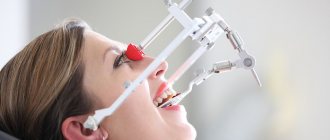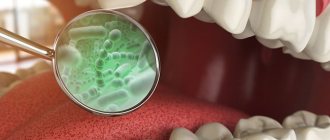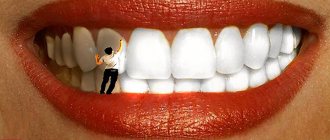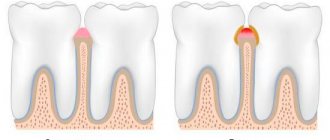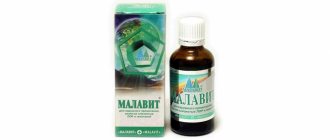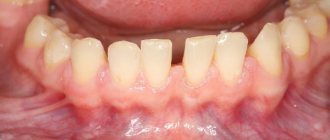Author of the article:
Soldatova Lyudmila Nikolaevna
Candidate of Medical Sciences, Professor of the Department of Clinical Dentistry of the St. Petersburg Medical and Social Institute, Chief Physician of the Alfa-Dent Dental Clinic, St. Petersburg
Not only the health of teeth and gums, but also the functioning of the digestive, immune and other systems and organs depends on the state of the oral microflora. Let's figure out what this part of the body is, what affects the conditions of the oral cavity and how to quickly restore the normal functioning of the microflora.
What is the microflora of the oral cavity?
Surprisingly, approximately 160 species of microorganisms live in the mouth of a healthy person. You've probably heard that “the mouth is the dirtiest place in the body.” This statement is partly true: the oral cavity is one of the most populated parts of the human body.
Microorganisms enter the oral cavity with food and water, as well as from the air. It is in the mouth that the most favorable conditions for the development of bacteria are observed. This part of the body always has uniform humidity and temperature (approximately 37 °C). The abundance of nutrients, sufficient oxygen content, the presence of folds in the oral cavity, interdental spaces and gum pockets, and slightly alkaline pH provoke the proliferation of various bacteria.
Microorganisms are unevenly distributed in the oral cavity. Their maximum number is observed on the surface of the teeth and on the back of the tongue. One gram of dental plaque contains approximately 300 billion microbes, and saliva contains approximately 900 million per 1 milliliter.
- 30-60% of the microflora are facultative and obligate anaerobic streptococci;
- part is occupied by Veillonella, coccobacteria, which ferment acetic, pyruvic and lactic acids to water and carbon dioxide. It is Veillonella that neutralizes acidic foods, so many dentists consider them as destroyers of cariogenic bacteria;
- Bacteria of the genera Propionibacterium, Corynebacterium and Eubacterium are also necessarily present in the mouth, which actively produce molecular oxygen, synthesize vitamin K and promote the development of obligate anaerobes. Some types of such bacteria provoke purulent inflammation.
- Lactobacilli are strict anaerobes. There are more than 10 types of similar bacteria in the mouth that form a biofilm in the cavity. The vital activity of these microorganisms creates a favorable environment for the development of normal microflora. Lactobacilli ferment carbohydrates to form lactic acid, lower the pH, and most importantly, prevent the development of pathogenic, putrefactive and gas-forming microflora.
- Rod-shaped lactobacilli in a certain amount are, like streptococci, producers of lactic acid.
- Bifidobacteria are necessary to ferment various carbohydrates, as well as produce B vitamins and antimicrobial substances that inhibit the growth of pathogenic microorganisms. Moreover, bifidobacteria are a bunch of epithelial cell receptors: they form a film that prevents the colonization of pathogenic bacteria.
It would take a very long time to list all the types of bacteria that populate the microflora of the oral cavity. It is important to understand that each person is unique, and to assess the “normality” of the microflora, you need to know the characteristics of a particular organism.
For example, in one case, a large number of lactobacilli in the oral cavity will preserve teeth, and in another, the formation of a large amount of lactic acid during their vital activity will retard the growth of other important microorganisms. The number of staphylococci, dysentery and typhoid bacilli decreases, carious processes become more active, and the microflora of the oral cavity will have to be restored.
Microbiota of the oral cavity and its connection with the occurrence of local and generalized infection
There is an opinion that the oral cavity is one of the dirtiest places in the entire human body. One can argue with this statement, but, according to scientists, saliva and oral fluid contain on average 109 microorganisms per 1 milliliter, and dental plaque contains 1011 per gram. According to the latest data, 688 species of different bacteria live in the mouth of a person who does not suffer from pathologies of the oral cavity [1].
Despite such a diversity of microbiota, with good hygiene and the absence of somatic diseases and mental disorders (such as diabetes, AIDS, constant stress and many others), we live in peace and harmony with the colonizers of the mucous membranes of our oral cavity. The presence of certain microorganisms in the oral cavity can serve as a diagnostic sign (for example, fungal diseases of the mucous membrane can be a sign of disorders of the T-cell immunity).
But, in addition to the mucous membranes, microorganisms also colonize the surface of the hard tissues of the tooth. As everyone knows, this leads to caries, and if you postpone a visit to the dentist and let the process take its course, it leads to complications such as pulpitis, periodontitis, and in the future to the formation of granulomas and cysts. Knowledge about the presence of certain representatives of the microcosm in the oral cavity, as well as about their physiological characteristics, allows us to find new ways to combat the pathologies that they can cause. The study of the oral microbiome has not lost its relevance today. Periodically, reports appear about the discovery of new representatives or the deciphering of the genomes of previously found bacteria. All this is necessary for a deeper understanding of the pathogenesis of diseases of the oral cavity, studying interbacterial interactions and improving the processes of treatment and recovery of patients, as well as the prevention of local and generalized complications.
As already mentioned, the human oral cavity normally contains a large number of different types of bacteria that do not live separately, but enter into various interactions, for example, forming biofilms. The entire microbiome of the oral cavity can be conditionally divided into two groups: permanent (species specific to a given biotope) and non-permanent microorganisms (immigrants from other host biotypes, for example, nasopharynx, intestines). A third type of microorganism may also be present—introduced microbiota from the environment.
Among the representatives of the normal microbiota, one can distinguish various types of actinomycetes (Actinomyces cardiffensis, A. dentalis, A. oris, A. odontolyticus, etc.), representatives of the genus Bacteroidetes (taxa 509, 505, 507, 511, etc.), Bifidobacterium (B. dentium, B. longum, B. breve, etc.), Campylobacter (C. gracilis, C. gingivalis, C. sputorum, etc.), Fusobacterium (F. periodonticum, F. gonidiaformans, F. hwasookii, etc.), Staphylococcus (S. warneri, S. epidermidis, etc.), Streptococcus (St. mutans, St. intermedius, St. lactarius, etc.) [1]. Despite its diversity, the species composition of the oral microbiota is quite constant, but the number of microbes of different species may fluctuate due to their species and changing environmental conditions. The quantitative composition of the microbiota can be influenced [2]:
- condition of the oral mucosa,
- physical conditions (temperature, pH, etc.),
- secretion of saliva and its composition,
- condition of hard dental tissues,
- food composition,
- hygienic condition of the oral cavity,
- absence of pathologies of the salivary glands, chewing and swallowing functions,
- natural resistance of the body.
Bacteria are retained on the surface of hard and soft tissues due to their morphological characteristics and certain intercellular interactions, which will be described below. Different types of bacteria have tropism for different tissues. For a further story about the formation of oral biofilms and the development of pathological processes, it is necessary to consider the main features of the predominant microorganisms.
This genus of bacteria is represented by immobile gram-positive cocci, located in “grape bunches” in the smear; are facultative anaerobes, chemoorganotrophs [5]. The most common representative of this genus in the oral cavity is Staphylococcus epidermidis, mainly located on the gums and in dental plaque. Breaks down food debris in the mouth and participates in the formation of dental plaque. Another common representative, Staphylococcus aureus, is the cause of the development of purulent bacterial infections, including generalized ones.
Disturbance of oral microflora: causes
Oral dysbiosis can be caused by a variety of diseases and problems. Violation of opportunistic microflora of the oral cavity most often causes problems such as:
- Diseases of the gastrointestinal tract. Malfunctions of the digestive organs lead to a slowdown in metabolic processes in the body. The absorption of vitamins and nutrients deteriorates, the balance of the intestinal bacterial environment is disrupted, which provokes problems in other organs and systems.
- Decreased immunity. If the body's resistance deteriorates, the oral cavity automatically becomes more vulnerable to pathogenic microflora.
- Chronic diseases. Often, small caries or stomatitis, if left untreated, can spread from the source of inflammation to the entire oral cavity.
- Bad habits, such as systematic drinking of alcohol and smoking, inevitably affect the quality of the salivary glands. Prolonged drying out or too much moisture in the oral cavity has a detrimental effect on the composition of the microflora.
- Poor nutrition and lack of vitamins worsens the quality of saliva and makes the microflora of the oral cavity more vulnerable.
- Taking antibiotics and certain medications, such as hormones;
- Wearing dentures.
Digestion in the mouth
The first stage of digestion begins in the oral cavity, where food is crushed/chewed and processed by a secretion called saliva.
(Up to 1.5 liters of saliva are produced daily.) In fact, the digestion process begins even before food touches our lips, since the very thought of food already fills our mouth with saliva. Saliva is a secretion secreted by three paired salivary glands. It is 99% water and contains enzymes, the most important of which is alpha-amylase, which is involved in the hydrolysis/breakdown of carbohydrates. That is, of all food components (proteins, fats and carbohydrates), only carbohydrates begin to hydrolyze in the oral cavity! Salivary enzymes do not act on either fats or proteins. The process of carbohydrate breakdown requires an alkaline environment!
The composition of saliva also includes: lysozyme, which has bactericidal properties and serves as a local protective factor for the oral mucosa; and mucin, a mucus-like substance that forms a smooth, chewable bolus of food that is easy to swallow and transport through the esophagus into the stomach.
Why is it important to chew your food well? Firstly, in order to grind it well and moisten it with saliva, and start the digestion process. Secondly, in Eastern medicine, teeth are associated with energy channels (meridians) passing through them. Chewing activates the movement of energy through the channels. The destruction of certain teeth indicates problems in the corresponding organs and systems of the body.
We don't think about the saliva in our mouth and don't notice its absence. We often walk around for a long time with a feeling of dry mouth. And saliva contains many chemicals necessary for good digestion and the preservation of the oral mucosa. Its release depends on pleasant, familiar smells and tastes. Saliva provides the taste of food. Molecules broken down in saliva reach 10,000 taste buds on the tongue, which can detect and highlight sweet, sour, bitter, spicy and salty tastes even in new foods. This allows you to perceive food as a pleasure, an enjoyment of tastes. Without moisture we cannot taste. If the tongue is dry, then we don’t feel like we’re eating. Without saliva we cannot swallow.
Therefore, it is so important for healthy digestion to eat food in a calm environment, not “on the run,” in beautiful dishes, tasty prepared. It is important, without rushing and without being distracted by reading, talking or watching TV, to chew your food slowly, enjoying the variety of taste sensations. It is important to eat at the same time, as this promotes secretory regulation. It is important to drink enough plain water at least 30 minutes before meals and an hour after meals. Water is necessary for the formation of saliva and other digestive juices, and the activation of enzymes.
It is difficult to maintain an alkaline balance in the oral cavity if a person constantly eats something, especially sweets, which always leads to acidification of the environment. After eating, it is recommended to rinse your mouth and/or chew something that tastes bitter, such as cardamom seeds or parsley.
And I also want to add about hygiene, cleaning teeth and gums. It was, and still is, a tradition among many peoples to brush their teeth with twigs and roots, which often have a bitter, astringent taste. And tooth powders also taste bitter. Bitter and astringent tastes are cleansing, have a bactericidal effect, and increase the secretion of saliva. While the sweet taste, on the contrary, promotes the growth of bacteria and stagnation. But manufacturers of modern toothpastes (especially sweet children's ones) simply add antimicrobial agents and preservatives, and we turn a blind eye to this. In our area, the pine taste is bitter, tart/astringent. If children are not accustomed to sweet tastes, they will normally accept unsweetened toothpaste.
Let's get back to digestion. As soon as food enters the mouth, preparation for digestion begins in the stomach: hydrochloric acid is released and gastric juice enzymes are activated.
Stages of dysbiosis
Depending on the degree of development of the disease, dentists distinguish four stages of dysbiosis:
- Latent. The first, latent stage is characterized by subtle changes in the number of microorganisms of one strain. The patient feels well and does not experience any symptoms of inflammation.
- Subcompensated. The number of lactobacilli decreases, the disease has a blurred picture. The patient may feel discomfort in the oral cavity, but does not always understand that this is dysbacteriosis.
- Pathogenic. Lactobacilli are observed in minimal quantities in the oral cavity. The oral cavity begins to be populated by a facultative pathogenic environment.
- Decompensated. In addition to severe inflammation in the mouth, uncontrolled growth of yeast-like fungi occurs. The functioning of the salivary glands is disrupted, and an unpleasant taste and burning sensation occurs in the mouth.
Advanced forms of dysbiosis are characterized by symptoms such as:
- inflammation of the gums and mucous membranes;
- plaque on the teeth and surface of the tongue;
- bleeding gums;
- ulcers and blisters on mucous membranes;
- increased body temperature;
- swelling and soreness of the tongue;
- dry skin, sticking in the corners of the mouth.
Methods for restoring oral microflora
Treatment of dysbacteriosis depends, first of all, on the nature of the pathogen, which is determined on the basis of dental examination.
Unfortunately, making a diagnosis of dysbacteriosis is often difficult, since at the initial stage the disease does not manifest itself in any way. At the slightest suspicion of a disease, the dentist refers the patient to a smear from the surface of the mucous membranes, blood and urine tests.
Depending on the diagnosed cause of dysbiosis, the dentist may prescribe the following methods of treating the disease:
- Sanitation of the oral cavity. The doctor removes tartar and fills all teeth affected by caries, and, if possible, treats the gums and mucous membranes.
- Treating the oral cavity with antiseptics to eliminate pathogenic microorganisms.
- Taking immunostimulants to strengthen the body and activate its defenses.
- A course of probiotics to restore the balance of beneficial bacteria in the oral cavity.
- Taking vitamin complexes for general strengthening of the body with vitamin deficiency. Properly prescribed vitamins promote cell regeneration and strengthen bone tissue.
In rare cases, antifungal agents and antibiotics are prescribed.
As a rule, the duration of treatment for dysbiosis is 2-4 weeks and depends on the patient’s health status, the number of foci of inflammation and existing complications of the disease.
A reliable assistant in the fight against dysbiosis will be the probiotic complex ASEPTA PARODONTAL*, a source of lactobacilli to restore the microflora of the oral cavity. This unique complex with patented strains of lactobacilli and vitamin D has the ability to effectively restore oral microflora. The complex normalizes the bacterial flora in the oral cavity, eliminates bad breath and prevents the formation of biofilms of pathogenic microorganisms.
To improve the effectiveness of the prescribed therapy, dentists recommend giving up bad habits (at least for the duration of treatment), reviewing the diet, paying attention to plant foods, and be sure to take care of the oral cavity after each meal.
Possible complications of dysbiosis
It is important for each patient to closely monitor the state of the oral microflora. Lack of treatment for dysbiosis can lead to such unpleasant diseases as:
- pathological halitosis – bad breath caused by an imbalance of the oral microflora;
- caries – destruction of hard tooth tissues;
- pulpitis - inflammation of the pulp - the internal tissues of the tooth;
- periodontitis – inflammation of the tooth root membrane and adjacent tissues;
- gingivitis – inflammation of the oral mucosa;
- stomatitis – damage to the oral mucosa;
- periodontitis is a deep lesion of the periodontal tissue.
In addition, the close relationship between the state of the oral microflora and the state of the cardiovascular system has been scientifically proven. In 2008, it was proven in the USA that periodontal disease, as a source of chronic inflammation, is an independent risk factor for coronary heart disease (CHD).
So, now you know the role of normal oral microflora in the human body. Treat yourself carefully, and your healthy body will delight you every day.
What bacteria inhabit the oral cavity?
The permanent microflora of the mouth consists of 30 strains of microorganisms that are responsible for the most important functions. These strains include: streptococci, veillonella and diphtheroids.
Almost 300 species of microorganisms constantly reside in the oral cavity. Among them there are pathogenic - harmful. Suitable habitats for parasites are braces and plates, carious cavities, crowns, gum pockets, and the back of the tongue. Some teeth have a soft but thick layer of yellow plaque, which over time turns into dark tartar - this is the focus of harmful microorganisms.
Bacteria and microbes form a unique environment that is maintained in the normal state of the body and is capable of self-regulation. In the normal state of the oral microflora, beneficial bacteria outperform pathogenic bacteria.
Systematic hygienic teeth cleaning at the dentist is an essential attribute of a healthy and beautiful smile.
Every time we accept another patient for caries treatment, we are convinced that the price of professional hygiene is disproportionate to the consequences and costs that will have to be borne if it is not done.
It has been proven that even correct, scrupulous and constant home care is ineffective. 90% of adults brush their teeth ineffectively.
Teeth cleaning at Unit using modern technologies: Air Flow and ultrasound gives the maximum effect in maintaining a healthy balance of microflora and local immunity.
Sign up for professional cleaning
